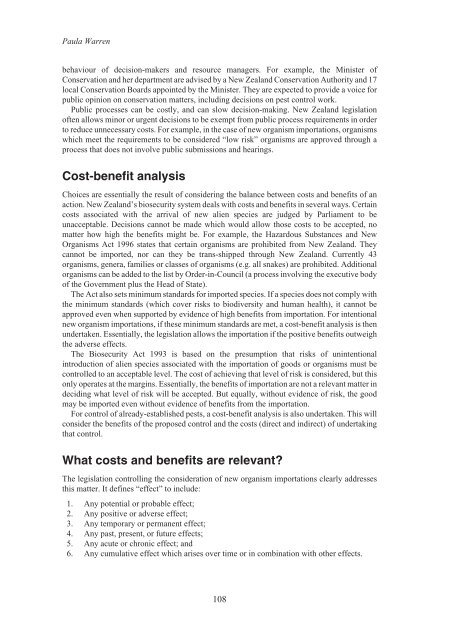Alien Species.vp - IUCN
Alien Species.vp - IUCN
Alien Species.vp - IUCN
You also want an ePaper? Increase the reach of your titles
YUMPU automatically turns print PDFs into web optimized ePapers that Google loves.
Paula Warren<br />
behaviour of decision-makers and resource managers. For example, the Minister of<br />
Conservation and her department are advised by a New Zealand Conservation Authority and 17<br />
local Conservation Boards appointed by the Minister. They are expected to provide a voice for<br />
public opinion on conservation matters, including decisions on pest control work.<br />
Public processes can be costly, and can slow decision-making. New Zealand legislation<br />
often allows minor or urgent decisions to be exempt from public process requirements in order<br />
to reduce unnecessary costs. For example, in the case of new organism importations, organisms<br />
which meet the requirements to be considered “low risk” organisms are approved through a<br />
process that does not involve public submissions and hearings.<br />
Cost-benefit analysis<br />
Choices are essentially the result of considering the balance between costs and benefits of an<br />
action. New Zealand’s biosecurity system deals with costs and benefits in several ways. Certain<br />
costs associated with the arrival of new alien species are judged by Parliament to be<br />
unacceptable. Decisions cannot be made which would allow those costs to be accepted, no<br />
matter how high the benefits might be. For example, the Hazardous Substances and New<br />
Organisms Act 1996 states that certain organisms are prohibited from New Zealand. They<br />
cannot be imported, nor can they be trans-shipped through New Zealand. Currently 43<br />
organisms, genera, families or classes of organisms (e.g. all snakes) are prohibited. Additional<br />
organisms can be added to the list by Order-in-Council (a process involving the executive body<br />
of the Government plus the Head of State).<br />
The Act also sets minimum standards for imported species. If a species does not comply with<br />
the minimum standards (which cover risks to biodiversity and human health), it cannot be<br />
approved even when supported by evidence of high benefits from importation. For intentional<br />
new organism importations, if these minimum standards are met, a cost-benefit analysis is then<br />
undertaken. Essentially, the legislation allows the importation if the positive benefits outweigh<br />
the adverse effects.<br />
The Biosecurity Act 1993 is based on the presumption that risks of unintentional<br />
introduction of alien species associated with the importation of goods or organisms must be<br />
controlled to an acceptable level. The cost of achieving that level of risk is considered, but this<br />
only operates at the margins. Essentially, the benefits of importation are not a relevant matter in<br />
deciding what level of risk will be accepted. But equally, without evidence of risk, the good<br />
may be imported even without evidence of benefits from the importation.<br />
For control of already-established pests, a cost-benefit analysis is also undertaken. This will<br />
consider the benefits of the proposed control and the costs (direct and indirect) of undertaking<br />
that control.<br />
What costs and benefits are relevant?<br />
The legislation controlling the consideration of new organism importations clearly addresses<br />
this matter. It defines “effect” to include:<br />
1. Any potential or probable effect;<br />
2. Any positive or adverse effect;<br />
3. Any temporary or permanent effect;<br />
4. Any past, present, or future effects;<br />
5. Any acute or chronic effect; and<br />
6. Any cumulative effect which arises over time or in combination with other effects.<br />
108












